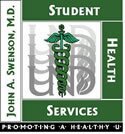|
Colds & Flu
Colds
The common cold can be caused by any of more than 200 viruses, which attack and multiply in the cells that line the nose and throat. Common colds are most commonly spread by hand-to-hand contact.
Symptoms of colds can include:
- Scratchy or sore throat
- Sneezing
- Clear nasal discharge
- Tenderness around the eyes
- Stuffy nose
- Tearing (watery) eyes
- Full feeling in the ears
- Acheness
- Cough, dry or with clear or white mucus
- General "tired" feeling
You should contact a medical practitioner if you experience:
- Discolored or bloody mucus from nasal passages
- Pain or tenderness around the eyes
- Painful swelling of the neck glands
- Cough with production of discolored mucus
- Painful breathing, wheezing, or shortness of breath
- Severe headache
- Fever greater than 100.5°F for longer than two days
- White patches on the back of the throat or tonsils or an extremely red throat
- Chronic, unusual fatigue
The common cold can be treated with over-the-counter medications including:
- Pseudophedrine (Sudafed) for congestion
- Antihistamines for runny nose
- Dextrometorphan for dry coughs
- Cough syrup with an expectorant (Robitussin) for coughs with phlegm
To help prevent the common cold, practice the following precautions:
- Wash your hands often and avoid touching your face
- Use disposable tissues
- Eat a balanced diet
- Avoid prolonged contact with people who have colds
- Keep your stress level down
- Keep your room humidity moderate to high
Flu
The Flu is a viral infection that can infect the nose, throat, and chest. The flu may last from a few days to a couple of weeks.
Signs and symptoms of the flu include:
- A fever, usually high, that lasts three to four days
- A prominent headache
- Muscle aches and pains
- Fatigue and weakness
- Stuffy nose
- Sneezing
- Sore throat
- Chest discomfort and cough
Know the Difference between a cold and the flu.
- A cold and the flu (also called influenza) are alike in many ways. But the flu can sometimes lead to more serious problems, such as the lung disease pneumonia.
- A stuffy nose, sore throat, and sneezing are usually signs of a cold.
- Tiredness, fever, headache, and major aches and pains probably mean you have the flu.
- Coughing can be a sign of either a cold or the flu, but a bad cough usually points to the flu.
Treatment can include the drug Amantadine to ease discomfort, if taken within 24-48 hours of the onset of symptoms. Bed rest is recommended if you have a fever, are feeling very tired, or ache all over. Stay in bed for a few days until you feel well enough to go back to normal activities. Taking Tylenol will reduce your fever and help relieve discomfort. Fluids should be increased while infected with the flu.
The flu shot is an annual vaccination that can prevent certain strains of the flu and can greatly lower your chance of getting the flu. If you are prone to being infected or live in close quarters with others, such as the dorms, you may wish to consider getting a flu shot. The best time to get the shot is from the middle of October to the middle of November, because most people get the flu in the winter. The shot can't cause the flu, but you may feel sore or weak or have a fever for a couple of days.
Almost all people who want to lower their chance of coming down with the flu can get a flu shot. In addition to older people, flu shots are also important for:
- people over six months old with health problems, like asthma, or with long-term diseases, like HIV or heart disease
- children or teenagers who must often take aspirin
- people who are often around the elderly or those with health problems
Know when to call your doctor. You usually do not have to call your doctor right away if you have signs of a cold or flu. But you should call your doctor in these situations:
- Your symptoms get worse.
- Your symptoms last a long time.
- After feeling a little better, you develop signs of a more serious problem. Some of these signs are a sick-to-your-stomach feeling, vomiting, high fever, shaking chills, chest pain, or coughing with thick, yellow-green mucus.
For more information, please contact Student Health Services.
Resource Links:
v US National Library of Medicine, Medicineplus Health Information. (www.nlm.nih.gov/medlineplus/commoncold.html)
v Centers for Disease Control and Prevention, Issues in Child Care Settings, The Common Cold in the Child Care Setting. (www.cdc.gov/ncidod/hip/abc/facts07.htm)
v National Institute of Health. Is it a cold or the flu? (www.niaid.nih.gov/publications/cold/sick.htm)
v US Food and Drug Administration. What to do for colds and flu. (www.fda.gov/opacom/lowlit/clds&flu.html)
v Health World Online, Medical Self-Care. Flu. (www.healthy.net/asp/templates/Article.asp?Id=1551)
|
|


